#built 1914
Explore tagged Tumblr posts
Text

4 notes
·
View notes
Text
Last year I found contemporary photos for each part of Jonathan's journey to Transylvania. This year, I thought I might go one better. Sound on.
Some notes under the cut.
All clips are from the 1890s (mostly Lumière footage) except Exeter and Romania, which are from 1935, as I couldn't find anything earlier. I tried to avoid anything obviously anachronistic in those shots but I might have missed things.
Peleș Castle is standing in for Castle Dracula. It's not in Transylvania but it is in the Carpathians, and I couldn't resist the shot of it peeking out through the trees. It was built between 1873 and 1914 but 1890s postcards show it as mostly complete.
Bram Stoker doesn't specify how Jonathan gets from London to Munich. The route via Brussels was suggested by Cook's Continental Time Table, Steamship and Air Services Guide 1892 and gave me an excuse to include the train pulling into Cologne (#trainfiend).
The music is this version of the Jonathan Creek theme tune, which is an adaptation of Saint-Saëns' Danse Macabre.
The title card is from Copycat Films.
2K notes
·
View notes
Text


This is incredible. It's a 4 story townhouse in a 1914 Neo-Gothic church conversion in Toronto, Canada. 3bds, 3ba, $1.895m.

This particular unit has the main entrance in a small side courtyard.


Enter this small area that the current owners have set up with a table and chairs.

To the left is a sitting area.

Coming up from the garage into the sitting area.

Note the original brick architectural features.



Straight ahead, there's the sleek, modern kitchen that has a counter with seating, but room for a table and chairs.

Look at these details- stone columns, gothic brick arches, and an illuminated custom catwalk.

View from the catwalk.

The workout room includes a shower in the corner.

Gothic arches, wooden trusses and cathedral ceilings.



The primary bedroom has built-in floating nightstands. The way they worked in the brick and wood details is gorgeous.



For an old church, everything is light, bright, and cheery. Look at the lovely ensuite.


Isn't this cute? They put a home office on the catwalk.


Large windows let in lots of natural light.


Very nice shower room.

This is the entrance from the garage.

It looks like you could fit 2 cars in here in tandem.
https://www.redfin.ca/on/toronto/40-Westmoreland-Ave-M6H-2Z7/unit-Th-7/home/165646207#property-details
193 notes
·
View notes
Photo
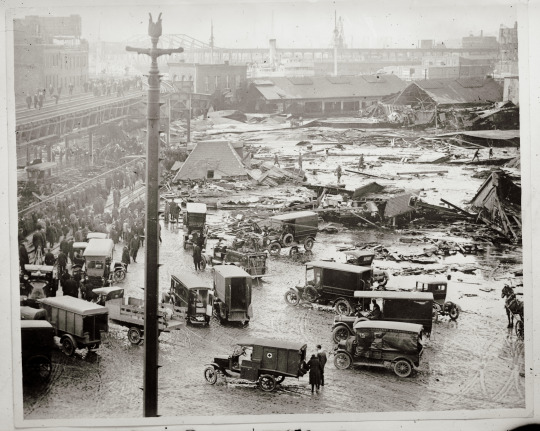
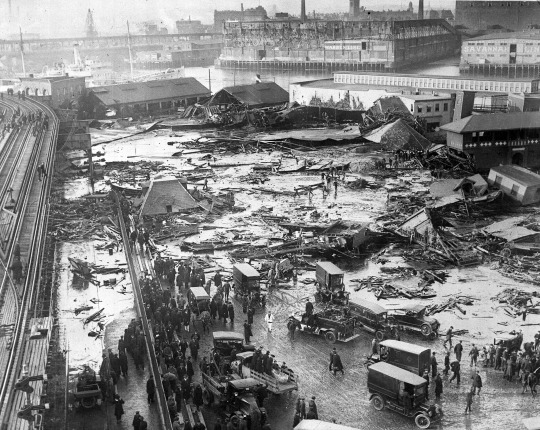
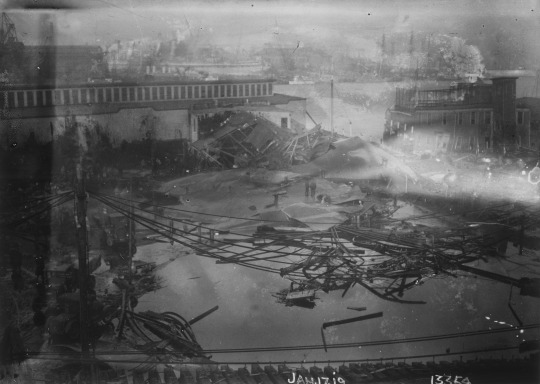

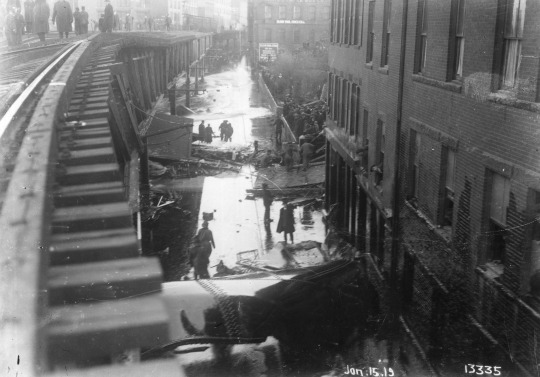
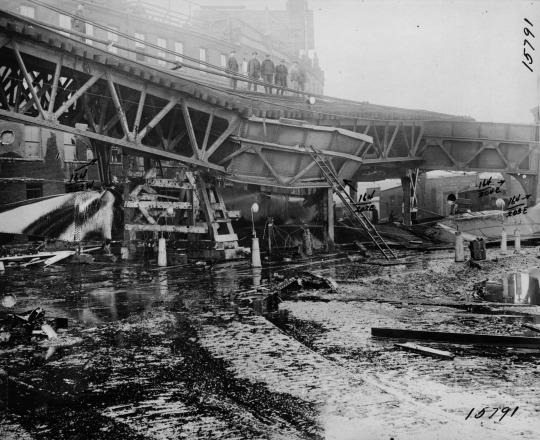
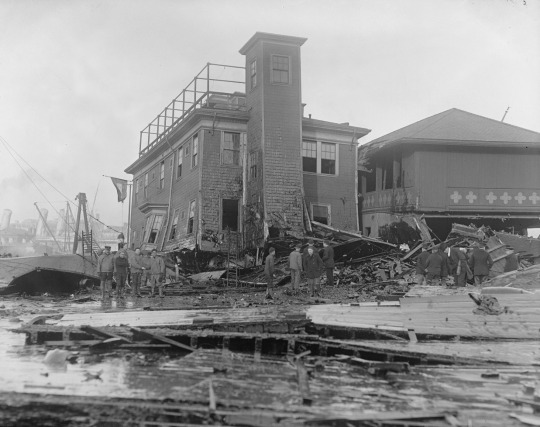

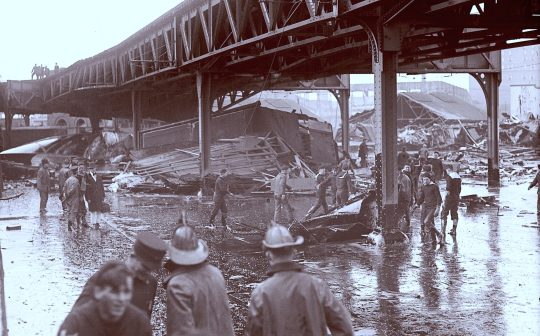
The Great Molasses Flood was a disaster in Boston that occurred after a storage tank collapsed on January 15, 1919, sending more than two million gallons (eight million litres) of molasses flowing through the city’s North End. The deluge caused extensive damage and killed 21 people.
The tank was built in 1915 along Boston’s waterfront on Commercial Street, opposite Copp’s Hill. It was operated by the Purity Distilling Company, a subsidiary of United States Industrial Alcohol (USIA). At the time, industrial alcohol—then made from fermented molasses—was highly profitable; it was used to make munitions and other weaponry for World War I (1914–18). The tank’s immense size reflected the demand: it measured more than 50 feet (15 metres) high and 90 feet (27 metres) in diameter and could hold up to 2.5 million gallons (9.5 million litres) of molasses. Built quickly, the tank was problematic from the start, leaking and often emitting rumbling noises. Nevertheless, it continued to be used, and after the war’s conclusion USIA focused on producing grain alcohol, which was in high demand as prohibition neared passage.
At approximately 12:30 PM on January 15, 1919, the tank burst, releasing a deluge of “sweet, sticky death.” According to reports, the resulting wave of molasses was 15 to 40 feet (5 to 12 metres) high and some 160 feet (49 metres) wide. Traveling at approximately 35 miles (56 km) per hour, it destroyed several city blocks, leveling buildings and damaging automobiles. Although help arrived quickly, the hardening molasses made rescue efforts difficult. In the end, 21 people were killed, many of whom were suffocated by the syrup, and approximately 150 were injured. In addition, the Boston Post noted that a number of horses had “died like so many flies on sticky fly paper.” Clean-up efforts lasted for weeks, and Boston reportedly continued to smell like molasses for years afterward.
Numerous lawsuits were filed in the wake of the disaster. While victims alleged that the tank was not safe, USIA claimed that it had been sabotaged by “evilly disposed persons.” In 1925, however, it was ruled that the tank was unsound, and USIA was ordered to pay damages. In addition, the disaster resulted in stricter construction codes being adopted by states across the country.
For years, questions were raised over how such a seemingly benign substance could have caused so many deaths. In 2016, researchers released a study that placed the blame on cold temperatures. While warm weather would have caused the molasses to be less viscous, the winter temperatures made the syrup markedly thicker, severely impeding rescuers.
653 notes
·
View notes
Text

Today we're heading into the eternal ice of Antarctica and keeping a special lady company. The beautiful Endurance is waiting for us in door no. 7

More about her here:
The three-masted schooner barque designed by Ole Aanderud Larsen (1884-1964) was built by the Framnæs shipyard in Sandefjord, Norway. When she was launched on 17 December 1912, she was named Polaris. She was 43.8 m long, 7.62 m wide and weighed 350 tonnes. In addition to square sails on the foremast and gaff sails on the main and mizzen masts, she had a 260 kW steam engine, which allowed a maximum speed of 10 knots (19 km/h). The ship was designed for polar conditions and constructed to minimise the pressure of the ice masses. With a thickness of 28 cm, the frames were made of greenheart wood, a particularly stable type of tropical wood, and were twice as thick as on conventional sailing ships of this size. The hull of the Endurance was designed to be relatively straight-sided, as it was only intended to sail in loose pack ice. She was therefore calmer in the sea than ships with a spherical hull, such as the Fram; however, this came at the cost of not being lifted significantly out of the pressure line in ice pressures and was therefore unsuitable for encasements in pack ice.
The ship was commissioned by the Belgian polar explorer Adrien de Gerlache and the Norwegian whaling magnate Lars Christensen, who actually wanted to use it for polar cruises of a more touristic nature. However, due to financial problems, Christensen was happy to sell his ship to Shackleton for 11,600 pounds sterling (approx. 934,000 euros, as of 2010) - an amount that was less than the original construction costs. Shackleton renamed her Endurance after his family's motto ‘Fortitudine vincimus’ (‘Through endurance we shall conquer’).
The Endurance left the port of Plymouth on 8 August 1914, around a week after Great Britain's entry into the First World War, and completed the journey to Antarctica with a stopover in Buenos Aires without any problems.
Before the crew of the Endurance could cross to the Antarctic mainland to cross the Antarctic as planned, the ship was trapped by the pack ice of the Weddell Sea in January 1915 like ‘an almond in a piece of chocolate’ - as the much-used comparison goes. After resisting the force of the pack ice for 281 days, the Endurance was crushed by the ice on 21 November 1915. The expedition team had previously saved themselves on a safe ice floe. Thanks to a masterly feat of seamanship and navigation, Shackleton and his crew managed to get out of this desolate situation without any losses with the help of three lifeboats that were salvaged from the Endurance.
Initially continuing with the pack ice and later on ice floes, the castaways drifted northwards in their camps along the Antarctic Peninsula until the floes broke into small pieces. They finally reached Elephant Island in their lifeboats. There, one of the boats was converted and set off for South Georgia with 6 men to fetch help, which was successful. Months later, the remaining men who were still stuck on Elephant Island were rescued by a Chilean navy guard boat.
In 2019, a private expedition attempted to locate the wreck of the Endurance, but was unsuccessful.
In January 2022, the Endurance 22 expedition began the search. The S. A. Agulhas II brought the expedition, in which marine physicist Stefanie Arndt from the Alfred Wegener Institute took part,[3] to the last coordinates of the Endurance mentioned. From the historical records, the expedition members knew that the ship must have sunk at ♁68° 39′ 30″ S, 52° 26′ 30″ W. According to the rules of the Antarctic Treaty, the wreck is a protected historical site that may not be touched.
On 5 March 2022, the expedition found the ship with a diving robot at a depth of 3008 m, 7.7 km from the recorded position. Photographs showed the wreck standing upright in excellent condition.
#naval history#tall ship#endurance#ernest shackleton#early 20th century#antarctica#advent calendar#day 7
157 notes
·
View notes
Text
Happy #WorldAnteaterDay!
From House of Fabergé menagerie, here is a diamond-eyed jasper anteater figure purchased by The Walters Art Museum founder Henry Walters on a trip to St. Petersburg in 1900. Now in the museum’s permanent collection.

Anteater
House of Fabergé (Russian, est. 1842) (Manufacturer)
Peter Carl Fabergé (1846-1920)
c. 1900
jasper, diamonds
The Walters Art Museum
"This tiny diamond-eyed anteater was purchased by Henry Walters, founder of the Walters Art Museum, on a trip to St. Petersburg in 1900. The House of Fabergé began making hardstone animals in the 1890s and they proved popular with their elite clients. Queen Alexandra (wife of the British King Edward VIl) built a large collection, and production peaked in the years immediately before the outbreak of the First World War in 1914.
Objects such as this anteater were inspired by Japanese netsuke. Carl Fabergé owned over 500 of these. He married this admiration of Asian art with the rich Russian tradition of hardstone carving. The anteater is unusual among Fabergé's menagerie, although examples in bloodstone and quartz are also known.”
#animals in art#animal holiday#european art#20th century art#19th century art#anteater#World Anteater Day#sculpture#figure#figurine#jasper#precious stones#gemstones#Faberge#Russian art#Walters Art Museum
823 notes
·
View notes
Text

Gil Elvgren (1914–1980) - This Bicycle's Built for Woo, 1947.
151 notes
·
View notes
Text

Pine Bluff, Arkansas
built in 1914
137 notes
·
View notes
Text
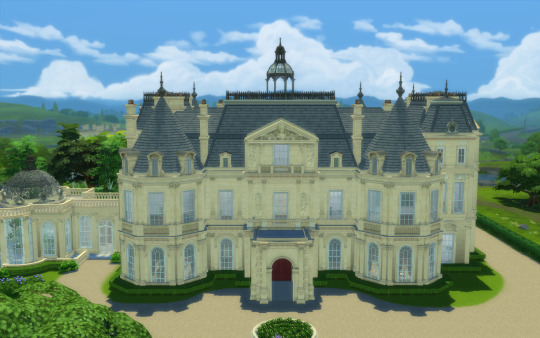
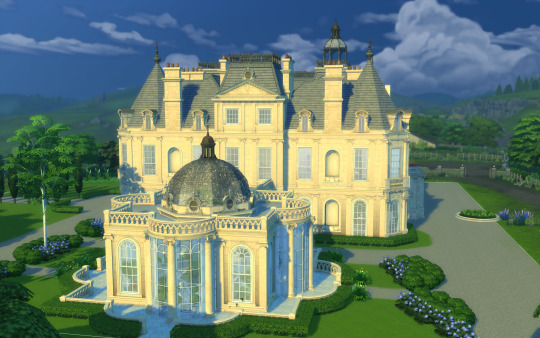
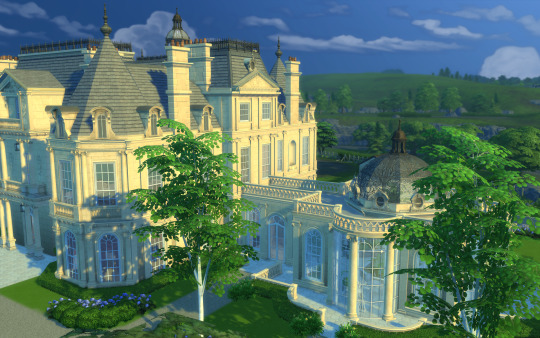
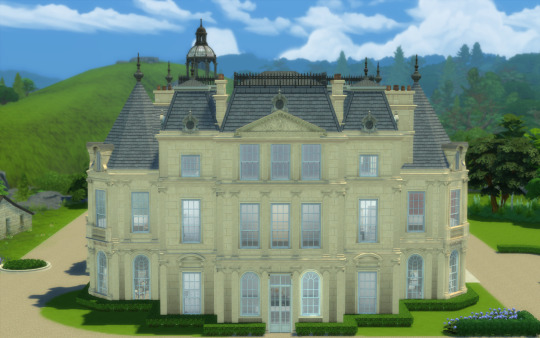
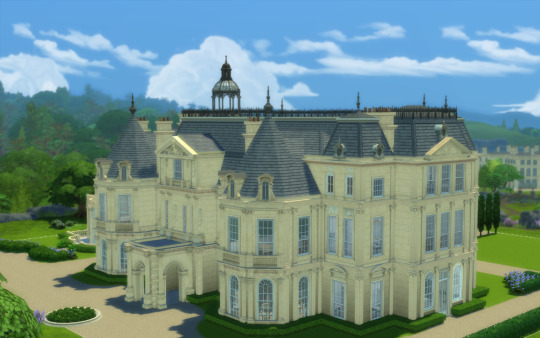

Halton House
Hace un instante
Hi guys!!
I'm sharing Halton House. This is the 15th building for my English Collection and the second Rothchild house I recreated.
I decorated some interiors for reference, but I could not find the real distribution of the house, so I just worked with pictures I found.
You might be familiar to the central hall and stairs, as they are the ones used for Bridgerton House in the series.
I chose to build the version with the conservatory, as I think this was a glory lost to time.
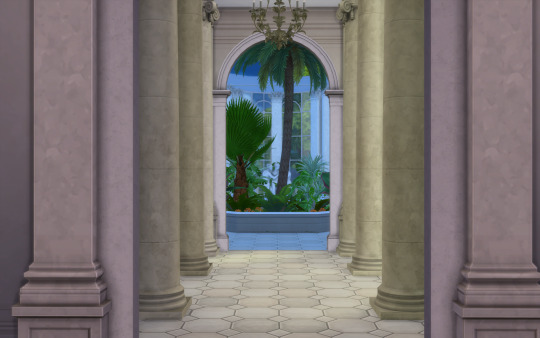

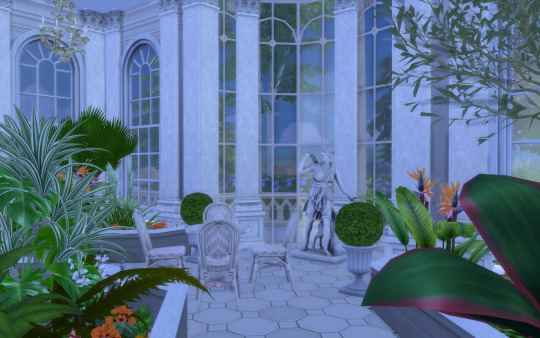
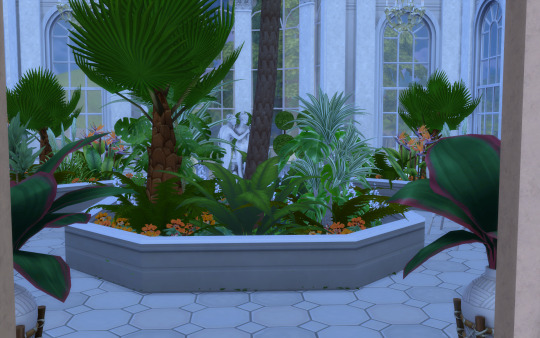

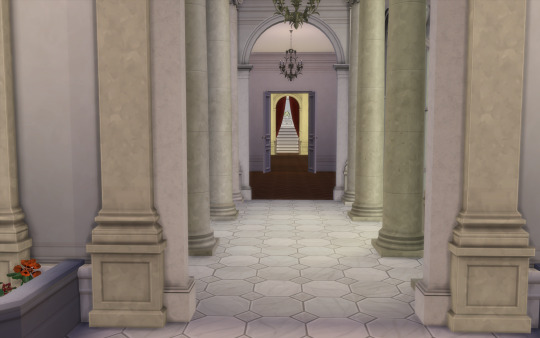
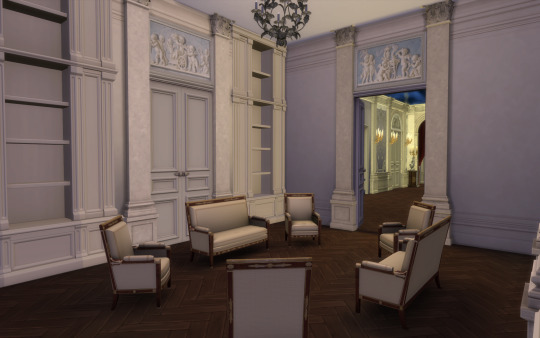
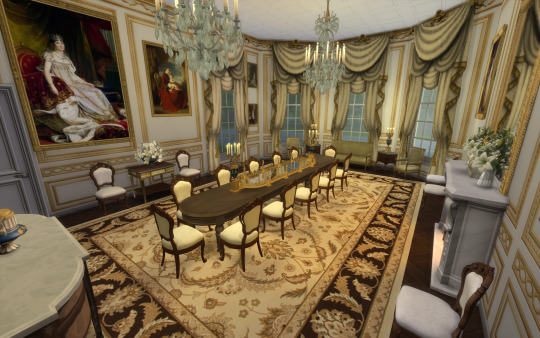
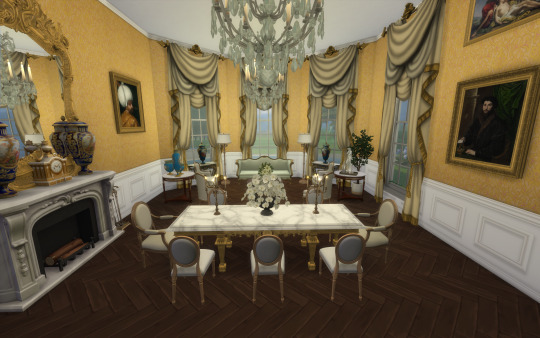



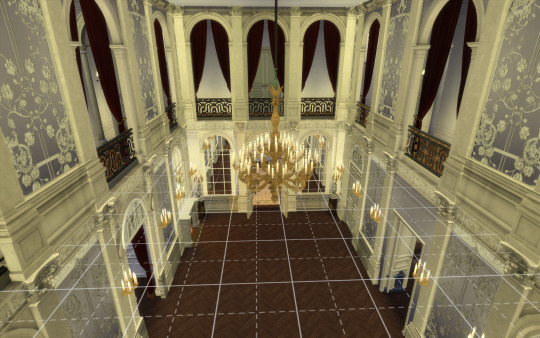
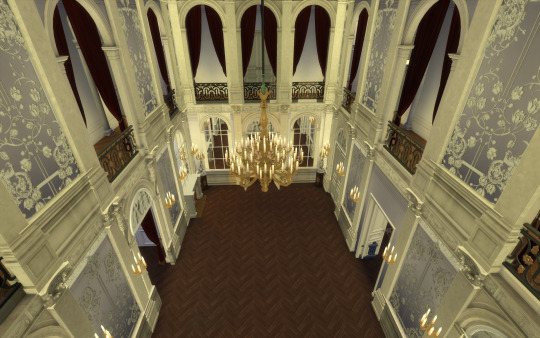


History of the house: Halton House is a country house in the Chiltern Hills above the village of Halton in Buckinghamshire, England. It was built for Alfred Freiherr de Rothschild between 1880 and 1883. It is used as the main officers' mess for RAF Halton and is listed Grade II* on the National Heritage List for England.
There has been a manor house at Halton since the Norman Conquest, when it belonged to the Archbishop of Canterbury. Thomas Cranmer sold the manor to Henry Bradshaw, Solicitor-General in the mid-16th century. After remaining in the Bradshaw family for some considerable time, it was sold to Sir Francis Dashwood in 1720 and was then held in the Dashwood family for almost 150 years.
The site of the old Halton House, or Manor, was west of the church in Halton village. It had a large park, which was later bisected by the Grand Union Canal. In June 1849 Sir George Dashwood auctioned the contents and, in 1853, the estate was sold to Lionel Freiherr de Rothschild.
Lionel then left the estate to his son Alfred Freiherr de Rothschild in 1879. At this time the estate covered an approximately 1,500-acre (610-hectare) triangle between Wendover, Aston Clinton, and Weston Turville.
It is thought the architect was William R. Rodriguez (also known as Rogers), who worked in the design team of William Cubitt and Company, the firm commissioned to build and oversee the project in 1880. Just three years later the house was finished.
The house was widely criticised by members of the establishment. The architect Eustace Balfour, a nephew of the Marquess of Salisbury, described it as a "combination of French Chateau and gambling house", and one of Gladstone's private secretaries called it an "exaggerated nightmare".
At Halton all were entertained by Alfred Freiherr de Rothschild. However, Halton's glittering life lasted less than thirty years, with the last party being in 1914 at the outbreak of World War I. Devastated by the carnage of the war, Freiherr de Rothschild's health began to fail and he died in 1918. Alfred had no legitimate children, so the house was bequeathed to his nephew Lionel Nathan de Rothschild. He detested the place and sold the contents at auction in 1918. The house and by now diminished estate were purchased for the Royal Air Force by the Air Ministry for what was even then a low price of £115,000 (equivalent to £7.08 million in 2023 pounds).
Architecture
For the style of the house Alfred was probably influenced by that of plans for the nearly completed Waddesdon Manor, the home of Baron Ferdinand de Rothschild, his brother-in law. While not so large there is a resemblance, but other continental influences appear to have crept in: classical pediments jut from mansard roofs, spires and gables jostle for attention, and the whole is surmounted by a cupola. The front of the house features a porte-cochère. A Rothschild cousin described it as: "looking like a giant wedding cake".
If the outside was extravagant, the interior was no anti-climax. The central hall (not unlike the galleried two-storey hall at Mentmore Towers) was furnished as the "grand salon". Two further drawing rooms (the east and west) continued the luxurious theme. The dining and billiards rooms too were furnished with 18th-century panelling and boiseries. The theme continued up the grand, plaster panelled staircase to the bedrooms. The whole was furnished in what became known as "Le Style Rothschild", that is, 18th-century French furniture, boulle, ebony, and ormolu, complemented by Old Masters and fine porcelain.
A huge domed conservatory known as the winter garden was attached to the house.
For more info: https://en.wikipedia.org/wiki/Halton_House
------------------------------------------------------------------------------
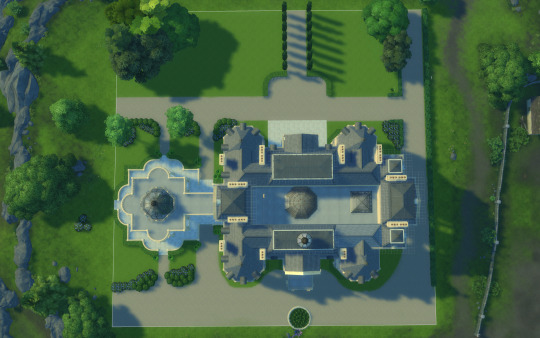
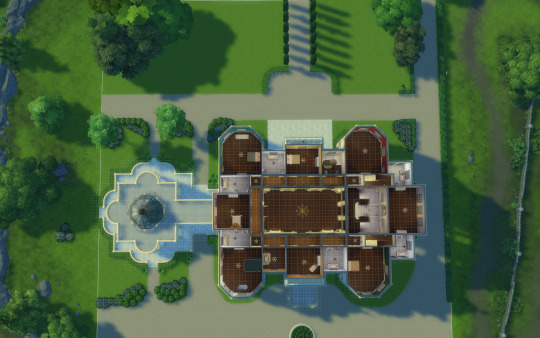
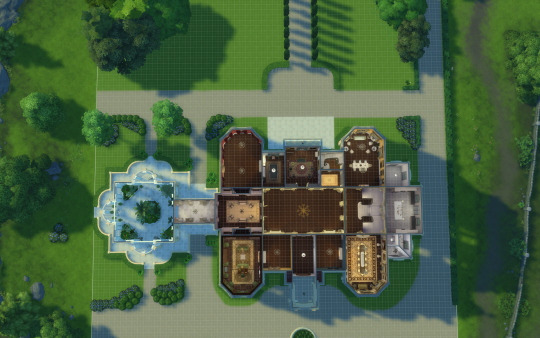
This house fits a 64x64 lot (You can fit the main building to the 50x50 or 50x40 lot if you lose the garden and conservatory)
I furnished just the principal rooms, so you get an idea. The rest is unfurnished so you create the interiors to your taste!
Hope you like it.
You will need the usual CC I use:
all Felixandre cc
all The Jim
SYB
Anachrosims
Regal Sims
King Falcon railing
The Golden Sanctuary
Cliffou
Dndr recolors
Harrie cc
Tuds
Lili's palace cc
Please enjoy, comment if you like it and share pictures with me if you use my creations!
Early access: 08/18/2024
DOWNLOAD: https://www.patreon.com/user?u=75230453
#sims 4 architecture#sims 4 build#sims4#sims 4 screenshots#sims4building#sims4play#sims 4 historical#sims4palace#sims 4 royalty#ts4#sims4life#sims 4 cc#sims 4#sims 4 legacy#sims 4 gameplay#thesims4#the sims 4#ts4cc#ts4 download#ts4 simblr#ts4 gameplay#my sims#sims community#simblr#ts4 screenshots#ts4 legacy
132 notes
·
View notes
Text




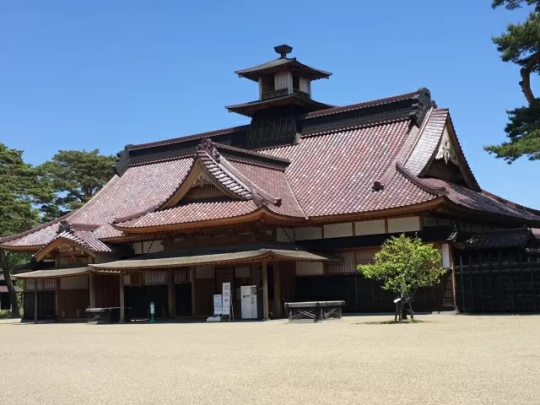




Sean bienvenidos a una nueva entrega de cultura e historia japonesa; en este caso vamos a hablar sobre Goryokaku, localizado en Hakodate en la prefectura de Hokkaido al norte de la isla de Honshu. - Para proseguir con la aventura, en el capítulo anterior comentamos el origen del nombre de Hokkaido, conocido como Ezo, mencionamos que estuvo 260 años encerrado bajo el shogunato Tokugawa e hicimos mención al tratado de amistad de 1854. - Hay algunos historiadores que consideran la fecha anteriormente mencionada como fin del periodo Edo, pero eso es un gran error y yo discrepo mucho en ello, ya que oficialmente termina en 1868, pero para mí y para algunos pocos sería en 1869 con la república de Ezo liderada por Toshizo Hijikata, quien realizó las obras del castillo Goryokaku de traza italiana. - El Goryokaku se construyó en 1864, para el calendario, japonés (Genji 1) y en 2024 se cumplen 160 años de su construcción. Dicho lugar fue tomado para la película y anime Golden Kamuy. - El Shogunato construyó Goryokaku con el propósito de garantizar el norte y la posterior apertura del puerto, ya a partir de 1857,el cual tardó siete años en completarse. La Oficina del Magistrado de Hakodate fue construida en el centro y está protegida por un foso. Después de ser utilizada como oficina gubernamental durante unos cuatro años, se convirtió en una base para el antiguo ejército del shogunato durante la Guerra de Hakodate, la batalla más decisiva de la Guerra Boshin,fue desmantelado en 1871 (Meiji 4) después de que terminara la guerra. Un tercio del edificio ha sido restaurado en el mismo lugar utilizando el mismo diseño, método de construcción y tamaño,Goryokaku, donde se demolió la oficina del magistrado de Hakodate, el castillo, se abrió al público como Parque Goryokaku en 1914 (Taisho 3). - Espero que os guste y nos vemos en próximas publicaciones y que pasen una feliz Navidad.
Welcome to a new installment of Japanese culture and history; in this case we are going to talk about Goryokaku, located in Hakodate in the Hokkaido prefecture in the north of the island of Honshu.
-
To continue with the adventure, in the previous chapter we discussed the origin of the name of Hokkaido, known as Ezo, we mentioned that it was enclosed for 260 years under the Tokugawa shogunate and we mentioned the friendship treaty of 1854.
-
There are some historians who consider the aforementioned date as the end of the Edo period, but that is a big mistake and I strongly disagree with it, since it officially ends in 1868, but for me and for a few others it would be in 1869 with the Ezo republic led by Toshizo Hijikata, who carried out the works on the Italian-style Goryokaku castle.
-
Goryokaku was built in 1864, according to the Japanese calendar (Genji 1), and 2024 marks the 160th anniversary of its construction. The site was used for the film and anime Golden Kamuy.
Goryokaku was built by the Shogunate for the purpose of securing the north and the subsequent opening of the port, as early as 1857, which took seven years to complete. The Hakodate Magistrate's Office was built in the center and is protected by a moat. After being used as a government office for about four years, it became a base for the former shogunate army during the Hakodate War, the most decisive battle of the Boshin War, and was dismantled in 1871 (Meiji 4) after the war ended. One third of the building has been restored on the same site using the same design, construction method and size.Goryokaku, where the Hakodate magistrate's office was demolished, the castle was opened to the public as Goryokaku Park in 1914 (Taisho 3).
-
I hope you like it and see you in future posts and have a happy Christmas.
-
日本の文化と歴史の新しい記事へようこそ。今回は、本州の北、北海道の函館にある五稜郭について話します。 - 冒険を続けるために、前の章では、蝦夷として知られる北海道の名前の由来について説明し、北海道が 260 年間徳川幕府の下に封鎖されていること、そして 1854 年の友好条約について触れました。 - 前述の日付を江戸時代の終わりと考える歴史家もいますが、それは大きな間違いであり、私はそれに強く反対します。なぜなら、江戸時代の終わりは公式には 1868 年であるからです。しかし、私や少数の人にとっては、それは 1869 年になるでしょう。イタリア式五稜郭の工事を行った土方歳三率いる蝦夷共和国。 - 五稜郭は元治元年(1864)年に建造され、2024年には築160年を迎えます。ここは映画・アニメ『ゴールデンカムイ』の舞台となった場所です。 - 五稜郭は北方の確保とその後の開港を目的として、1857年から幕府が7年の歳月をかけて建設されました。中心部には箱館奉行所が建てられ、堀で守られています。戊辰戦争最大の決戦となった箱館戦争では旧幕府軍の拠点となり、約4年間官庁として使用された後、終戦後の1871年(明治4年)に解体された。 。箱館奉行所城が取り壊された五稜郭は、同じ敷地内に同じ設計・工法・規模で建物の3分の1が復元され、1914年(大正3年)に五稜郭公園として公開されました。 - 気に入っていただければ、今後の投稿でお会いして、メ���ークリスマスをお過ごしください。
#photo#japan photos#photos#phothography#japanese#japanesehistory#japaneseculture#artjapan#arthistory#日本#ユネスコ#歴史#unesco#考古学#history#japan#archaeology#geography#art#地理#北海道#Hokkaido
96 notes
·
View notes
Text

Old house on the island Frösön, Sweden. Built 1914 as a two family house.
54 notes
·
View notes
Text

Never forget that thousands of Black workers died building the Panama Canal
By Stephen Millies
Donald Trump declared that if the Panama Canal’s tolls for ships passing through it didn’t decrease, he would seize the waterway. Trump’s fascist rant is like one of Hitler’s threats.
Listen up, billionaires: the Panama Canal belongs to Panama! This fact isn’t just because of geography.
Hundreds of thousands of Panamanians are descendants of those who built the canal. Between 1904 and 1914, the U.S. Government brought 100,000 Black workers from the Caribbean to cut through miles of rock.
52 notes
·
View notes
Text
Romanov myths part three - did the Grand Duchesses go shopping?
Over the years, a prevalent belief that the Romanov Grand Duchesses, Olga, Tatiana, Maria, and Anastasia, did not go shopping continues to be repeated. Some historians have even suggested that the girls did not know how paying for items worked. However, primary sources from people who knew the girls, were members of their entourage, and the Grand Duchesses' own diaries, tell a different story...
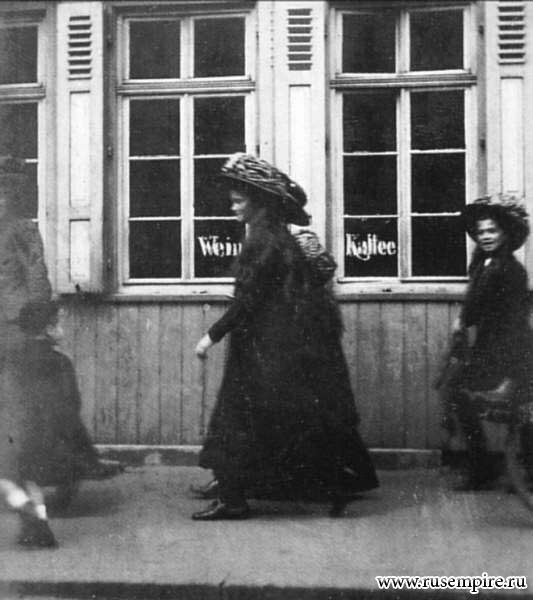
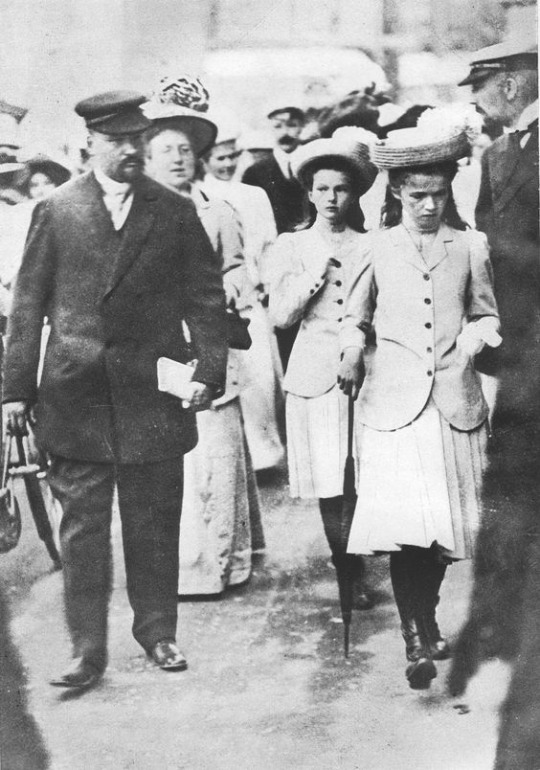
"Saturday. 10 August. … We walked along the historic boulevard and the main streets, but crowds followed us everywhere, so we were able to go into only 2 shops for a minute..." "Friday. 15 November. Had lessons, after that went shopping for wool with Nastenka as usual.." From Grand Duchess Olga Nikolaevna’s 1913 diary [my underlining]
In this entry, Olga describes shopping Countess Anastasia 'Nastenka' Vassilievna Hendrikova, who was a young lady-in-waiting at court and a particular favourite of the Grand Duchesses, often accompanying them on trips. As described in the first entry, it appears that safety and security concerns due to crowds, rather than a lack of understanding about shops, contributed to the Grand Duchesses not being able to shop frequently. Nastenka is frequently mentioned by the Grand Duchesses in their diaries, and volunteered to join the Romanov family in their house arrest and imprisonment. She was murdered by the Bolsheviks in September 1918.
"After coffee, I went for a walk with my pupils… They really liked to go to the shops and buy everything. Anastasia Nikolaevna was especially attracted to stores, where they sold doll shoes of various sizes… Tatiana Nikolaevna did not always accompany since the doctors found her heart was weak and she went with the Empress to take baths." A Few Years Before the Catastrophe by Sofia Ivanovna Tyutcheva.
Sofia Ivanovna Tyutcheva was a maid-of-honour to Tsarina Alexandra Feodorovna, and in 1907 was appointed as governess to the Grand Duchesses. The Grand Duchesses referred to her as "Savanna". She was dismissed in 1912 when she voiced concerns over Grigori Efimovich Rasputin. She wrote a short memoir in 1945, and passed away in 1957.
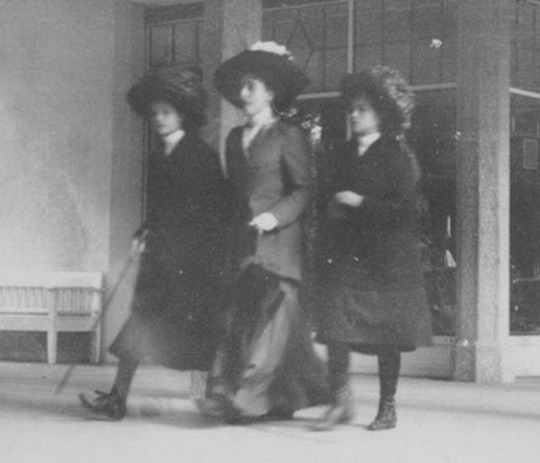
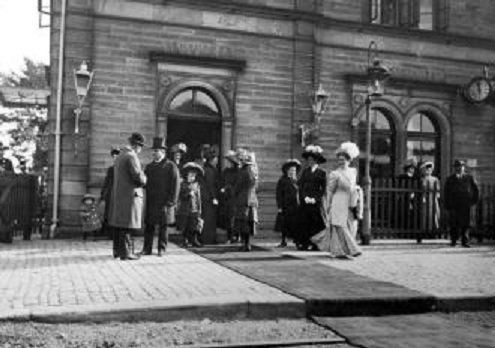
"[The] Grand Duchesses went shopping in the morning with one of the ladies-in-waiting to the Empress. They delighted in that because they could mix with the crowd and buy things just as everyone else did, and they were so pleased if they were not recognised at once." -- Upheaval - Olga Voronova [my underlining]
Countess Olga Konstantinovna Voronova was part of the aristocratic Kleinmichel family and in 1914, married one of the Romanov's favourite officers, Pavel Alexeievich Voronov. Through these connections, Olga Konstantinovna became a friend of the Grand Duchesses, exchanging frequent letters with Olga and Tatiana in particular, before and after the Revolution. She published her memoirs in 1932. Once again, it is inferred that being recognised and subsequent security concerns stifled the Grand Duchesses' shopping sprees.
Where did the myth come from?
It appears that the myth came about due to this extract from Margaretta Eagar, an Irish nanny who cared for the children from 1898 to 1904:
Her only knowledge of shops and shopping was derived from the toy and sweet shops in Darmstadt. One day she asked me why the Americans spoke English, not American. I told her the story of the Pilgrim Fathers, and described how they built houses and shops, and so made towns. She was exceedingly interested and inquired, ' Where did they find the toys to sell in the shops ? " Six Years at the Russian Court, by Margaretta Eagar
It appears that some historians forgot that Margaretta Eagar moved on from her nanny position in 1904, when the eldest Grand Duchess was nine and the youngest was three, and perhaps did not look for sources from when the Grand Duchesses had grown up and had slightly more independence.
Over time, the myth appears to have been exaggerated and repeated until it became part of the 'folklore' surrounding the Romanov Grand Duchesses, portraying them as isolated and naïve.
Whilst it is clear that the Grand Duchesses did enjoy going shopping in their lifetimes, safety and security concerns meant they could not enjoy shopping as frequently as other teenagers may have. In the same way royals today would not be able to go to shops without being recognised, there was a chance that a crowd could gather. Similarly, Olga and Tatiana appear to have shopped more than the younger pair, Maria and Anastasia, likely due to being older in age and therefore having more independence.
Photos:
First set, left: Olga, Anastasia (hidden behind Olga), and Maria Shopping in Germany, 1910. Right: Olga and Tatiana out shopping in the Isle of Wight, 1909, accompanied by Dr. Evgeny Botkin (in the suit)
Second set, left: Tatiana and Maria shopping with Sofia Ivanovna Tyutcheva, circa 1910. Right: The Grand Duchesses and their entourage by shops, most likely taken in Germany, 1910
Sources:
Journal of a Russian Grand Duchess: Complete Annotated 1913 Diary of Olga Romanov, Eldest Daughter of the Last Tsar, translator Helen Azar, (Independently published: 2015)
A Few Years Before the Catastrophe: The Memoirs of Sofia Ivanovna Tyutcheva, translator George Hawkins, (Independently published: 2020)
Upheaval, Olga Voronova (Woronoff), (New York; London: G. P. Putnam's Sons, 1932) -- Free to read online here
Six Years at the Russian Court, Margaretta Eagar, (New York: Charles L. Bowman and Company, 1906) -- Free to read online here
#Romanov#Romanov family#otma#Olga Nikolaevna#Tatiana Nikolaevna#Maria Nikolaevna#Anastasia Nikolaevna#sources#myths#myth-busting#Romanov sisters#Margaret Eagar#Margaretta Eagar#Sofia Ivanovna Tyutcheva#Nastenka Hendrikova#diaries#free to read#Olga Romanov#Tatiana Romanov#Maria Romanov#Anastasia Romanov
141 notes
·
View notes
Text

Statue Discovered at Greece’s Ancient Site of Philippi
A large public building with a statue depicting a young male built onto its wall, workshops, residences and thermal baths are only some of the new and glorious discoveries that have been recently unearthed at the archaeological site of ancient Philippi in northern Greece.
The ancient structures were discovered by archaeologists during ongoing works to install a fire safety and water distribution network at the sprawling site. The finds will shed even more light on the secrets and the past glory of the ancient city of Philippi, established in 356 BC by the King of Macedon and father of Alexander the Great, Philip II.
Archaeologists have long believed that Philippi was adorned by magnificent buildings and that the city had gained extraordinary fame after its establishment. During the current works at the Philippi site a geophysical method capable of detecting buried walls while guiding the pipelines without disturbing any of the antiquities was employed.

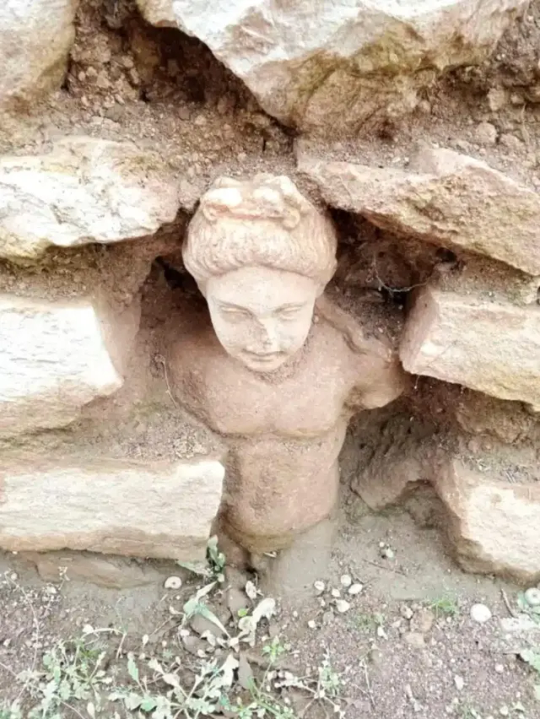

The ancient city of Philippi
Philippi was established in 356 BC by the King of Macedon, Philip II, on the site of the Thasian colony of Crenides near the head of the Aegean Sea. It developed as a “small Rome” with the establishment of the Roman Empire in the decades following the Battle of Philippi in 42 BC. Centuries later, it was abandoned after the Ottoman conquest of the 14th century. The present municipality of Filippoi is located near the ancient city’s ruins and is part of the region of East Macedonia and Thrace in Kavala, Greece.
The ancient city is currently the most vital archeological site in the region. However, the first excavations did not begin until the summer of 1914 and were soon interrupted by World War I. Between 1920 and 1937, archeologists unearthed the Greek theater, forum, baths and city walls. Following World War II, Greek archeologists returned to the site, uncovering multiple public buildings.
By Filio Kontrafouri.
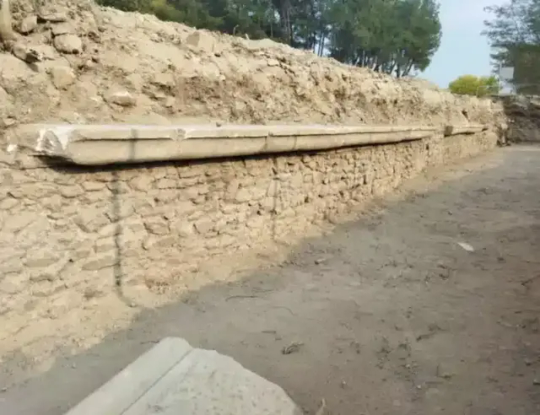
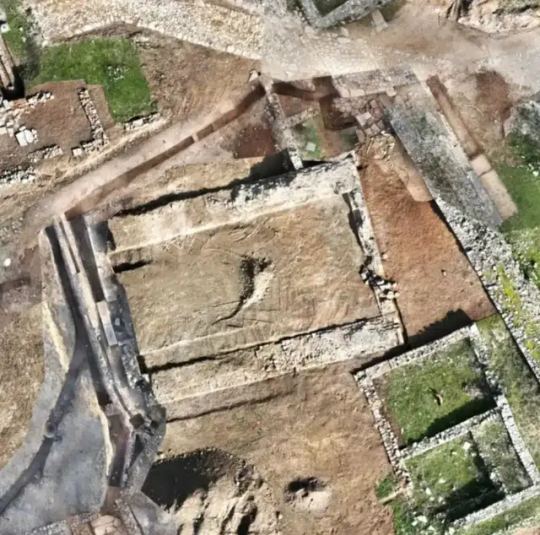
#Statue Discovered at Greece’s Ancient Site of Philippi#ancient city of Philippi#statue#ancient statues#ancient sculpture#ancient artifacts#archeology#archeolgst#history#history news#ancient history#ancient culture#ancient civilizations#ancient greece#greek history#greek art#ancient art
45 notes
·
View notes
Text
Title: I never had no regrets
Ship: Mike x Dude (old edition), Mike & Colorado Ryan
Words: 3.3k
Warnings: Major character death, religious themes
Description: Mike and Dude's last day together.
Dude groaned softly as he eased himself into his chair on the front porch. Dude rubbed his face and sighed. Mike came out of the house with two cups of coffee and the newspaper. Dude took the newspaper appreciatively and opened it. Mike sat down next to Dude silently. It was a warm morning, and they were dressed in their lightest patterned shirts. Dude still left his partially unbuttoned as he had in his youth.
July 16th, 1914. The little town hadn’t had its own newspaper when Dude came into it about 50 years ago. All the news was word of mouth then. The town was hardly much bigger now than it had been in 1860 but there were cars, and a pharmacy with a soda fountain had finally made its way over. Dude could drive a car now but he didn’t like to. Unfortunately, it was harder getting on horses now than it had been even 5 years ago. It was harder getting around at all.
The newspaper talked about how the school that had been built only 20 years ago was getting on. There was a war brewing in Europe. Woodrow Wilson was doing this and that for domestic policy.
“Anything good?” Mike asked him.
“The school’s doin’ well.”
Mike shook their head. “How this damn town lasted almost 30 years without a school, I’ll never know. You’d think they wanted a bunch of uneducated hicks.”
Dude frowned at them.
“I don’t mean you, Dude. You weren’t born here.”
“I’m an uneducated Texan hick, anyhow.”
“Well, you can read that newspaper,” Mike tried with some levity.
Dude only frowned more.
Mike shook their head. “Old age has killed your sense of humor.”
He laughed. “All these years, and you still ain’t funny.”
Mike feigned offense, but conceded, “One of us has to be the grumpy old man.”
Dude smiled. A couple of his teeth had fallen out and his lips were worn. He still had a pretty smile. Mike smiled back at him. They took one of his wrinkled hands in theirs. They frowned at a bruise on it.
“You better start being more careful Dude, you aren’t a young man anymore-”
Dude waved his hand. “Ah, you still worry too much. No man ever died of a bruise.”
“Well, if you fall-”
“Fall?! Who’s fallin’? Not me, that’s for damn sure,” Dude interrupted in indignation.
“You sound more like Chance every year.”
Mike and Dude looked vaguely in the direction of the jail, as if Chance could still be there. Dude pouted. “Am I really a hardass?”
“No, baby, but you’ve gotten especially stubborn and prideful.”
He sighed. “Yeah, I know. Gettin’ old…it ain’t a cakewalk.”
Mike squeezed his hand. “I’m here for you, always.”
Dude got a very serious look on his face. “I know. I only wish I could be there for you. My time’s coming, honey.”
Mike tilted their head. They tried to laugh. “You say that like you’re dying tomorrow.”
“I’m serious. I feel Heaven callin’.”
“But you’re sure it’s Heaven?”
“At night, I hear the angels.”
“Baby, you’re just dreaming. Just dreaming. Come on, let’s go for a walk in town, huh?”
Dude grabbed his old worn hat and the pair walked into town. It was still small, but it had acquired more streets in the past two decades. What had once been a single street, turned into 6 streets. Mike and Dude walked past the Wells Fargo that was still in the same spot next to the new pharmacy.
Dude stopped. “We should get two ice cream sodas.”
They frowned. “This early in the morning? Are you sure that’s good for-”
“Mike, I’m 75 years old. I know what’s good for me.”
“Oh, I know. I just care about you.”
Dude kissed their hand and they walked inside the pharmacy and came up to the counter. “Two coca-colas with chocolate ice cream, please.”
“That’ll be 10 cents,” said the man behind the counter. Dude dropped a dime on the counter.
Dude sat down carefully. “You know, I remember the first time I had a coca-cola.”
Mike laughed. “So do I. Did it still have cocaine in it then?”
Dude furrowed his eyebrows. “I don’t know. When did they take it out?”
“Ohhh, about 10 years ago.”
“Yeah, it probably did,” Dude said. “What a fool thing to drink.”
They both laughed.
The man behind the counter put down their ice cream sodas and they thanked him. They had their beverages and said little else.
Dude rolled himself a cigarette as they exited the pharmacy.
“They come pre-rolled now, Dude,” Mike teased.
“I like to roll ‘em myself.”
He pulled a lighter out of his pocket and lit his cigarette.
“You used to use matches,” Mike said reminiscently.
He shrugged. “It’s nice not to have to strike a match against something.”
Mike blushed for the first time in a long time. “You know, I always thought you were pretty when you smoked.”
Dude blew smoke out of the side of his mouth and asked amusedly, “Yeah?”
“Still do.”
Mike and Dude walked home.
Later on that evening, Mike lit the stove to reheat some soup they’d made yesterday. Dude sat at the table, watching.
“Honey, could you…” Dude stopped himself. “How ‘bout you fry up that good cut of pork belly in the icebox for me? And make me a nice glass of sweet tea, huh?”
Mike turned around. “I thought the pork belly was for when Colorado and his wife and kids come over on Saturday?”
Dude’s eyes were distant. “Mike, I ain’t gonna be here Saturday.”
Mike’s heart felt like it had been thrown into the bottom of the ocean. They bit their lip then released it. They told him sharply, “Dude, that is not funny.”
“I’m not bein’ funny. Mike, I’m not making it to Saturday.”
His mouth was drawn into a straight line. He looked 10 years older.
Mike lowered the flame on the stove and sniffed. “Are you sick? Was it the ice cream soda? Should I send for the doctor?”
Dude shook his head. “I’m fine. I don’t need no doctor.”
Mike looked at him for a long time. “Are you sure about the pork belly?”
Dude nodded. “Fry it up for me…with a couple of mashed potatoes and…do we still have the green beans?”
Mike nodded. “Alright. I’ll heat up this soup for me.”
Mike made Dude’s dinner exactly how he asked for it, and sat down with him to eat.
Dude always insisted on saying grace before meals, so the pair did so.
“When you pray tonight, could you ask God to take away whatever feeling you’re having?” Mike asked. They almost considered praying themselves. Please let God listen for once.
Dude gave them a small smile. “I will. But, I want you to know something. I never was any damn good with words. Mike, these past 34 years have been the best of my life. You’re the best thing that ever happened to me. If I could do it all over, I’d do it all the same so I always got to you. I wouldn’t trade a minute of it. I don’t regret not having kids with you, and when I go, don’t you think I ever did. I know how your mind is. Don’t go dwellin’ on any bad moment we had. I’m not mad at you. You’re the best damn husband a fella could have. I’m going out of this world grateful for you, you understand?”
Mike wiped their eyes. “I understand.”
Dude shoveled down his dinner like a starving man.
“Hungry?” Mike teased.
“Always for your cookin’, honey.”
Mike shook their head fondly. “You did get soft. You old sap.”
Dude grinned. “I was always soft on you.”
Mike reached out to stroke Dude’s face. “You better be here Saturday, Dude.”
“I’ll try, honey. I will.”
When the pair went to bed that night, Dude was insistent on sleeping naked as they did more often when they were younger. Mike didn’t mind Dude’s aged body. They were in love with every wrinkle, bruise, and sag. He retained some of his tan, though his days in the sun were shorter. He’d put on a bit of weight, but Mike loved that all the more. He still smelled like coffee and tobacco. Dude took a deep sniff of Mike’s hair.
“Always fruity. Used to be cucumber. Now more peachy.”
“You’re so handsome, you know that?” Mike whispered.
“As handsome as I used to be?”
Mike hugged Dude closer. “More handsome.”
“You’re lyin’, but I love you.”
“I love you too.”
Mike woke up slowly that morning with Dude still pressed close to them. They felt Dude’s thinning hair and sighed. As their hand fell onto his neck, their heart stopped dead in their chest. He was stone cold. Mike kept their eyes closed as they pushed themselves away. Their heart pounded in their chest. They almost tumbled off their bed, but were able to steady themselves. They opened their eyes slowly, to their husband still on the bed. He could almost have just been asleep, except his skin had become a strange shade of grey. They reached out slowly and felt his cheek. Cold. They knelt down and kissed him lightly on the forehead.
“Dude, I should have made a big speech to you too. You knew I loved you. I know you did. I don’t want to go on without you. But I will baby, I will. I guess I’m glad I knew…or had an idea. I hope you were always right and you’re in Heaven. Having breakfast with the angels. You’d fit right in. You are my angel. Watch me carefully, huh?”
For a long while, Mike didn’t move. They kneeled in front of the long gone Dude and caressed him. They held back tears. After some long amount of time that could have been an hour or two, they managed to stand. Their knees groaned on the way up. They grabbed their robe from the closet and tied it around themselves. They neglected putting on any shoes.
Mike walked out of their house into the Friday morning air. The warmth of the morning was an insult to how dead and cold Mike felt. They managed to get to Colorado’s farm. He had a good deal more land than Mike and Dude had ever acquired. With his 6 children, he needed it a lot more. They stumbled across the pathway past Colorado’s group of cows. They chuckled, remembering their sole cow back at the ranch. What a meager life they had lived.
Mike was greeted by Colorado’s youngest, Abilene. She had long brown hair, and favored her father. She was as girlish cute as he had once been boyish cute. She smiled.
“Why, good mornin’,” she drawled. “I thought me’n Pa ‘n Ma weren’t coming over ‘til tomorrow?”
Mike was grave. “I need to talk to your father.”
Abilene frowned then hurried inside. Colorado soon replaced her in the doorway. His brown hair was speckled with gray, and his boyish smile had flattened into a handsome, but aged grin.
“Hey, Mike. What can I do for you?” he asked.
“Dude’s dead, Colorado.”
His grin fell off his face. He laid a hand on Mike’s shoulder. “When?”
Mike’s resolve broke, and they cried. “Last night I think. I woke up this morning and oh, God.”
He pulled them into a hug. “It’s gonna be alright. You can stay here with me and Jennetta for a while, until we get the ranch straightened out.”
Mike shook their head. “No, it’s my ranch. I’m not selling. Dude and I built it together. It goes when I go and not a second before.”
“Did Dude write out a will?”
Mike shrugged. “I don’t know. All we have is the ranch, a car, and some livestock. And, who’s he going to leave it to if not me?”
“Where’d he want to be buried?”
Mike paused. “On the ranch.”
“Alright. I’ll go talk to the coroner about a death certificate, and we’ll see about a coffin and a headstone.”
Mike nodded solemnly. “Thank you.”
Colorado invited Mike inside to sit down at the coffee table while Colorado went out to set up Dude’s final proceedings. Jennetta made Mike a fresh cup of coffee.
“Sugar or no?” she asked.
“All the sugar you have.”
She laughed. She put a few teaspoons of sugar in Mike’s coffee along with a little milk. “You know, Abilene is getting married next month.”
“That boy, uh, Tommy?”
“Thomas, yes.”
“Well, congratulations,” Mike said to Abilene, who had just come back into the room. “One person loses a husband, another gains one. The world goes around.”
“I’m sorry for your loss,” said Abilene.
Mike stared into their coffee cup. “So am I. It’s so stupid but I thought somehow I would go first.”
“That’s not stupid,” Jennetta disagreed. “I hope the same thing about my Colorado sometimes.”
They laughed. “You’re only a year younger than Colorado.”
She feigned a smile. “Yeah…Mike…Dude’s in Heaven waiting for you.”
Mike frowned. “I don’t know. I don’t know about all that God stuff. I know Dude believed, and you and Colorado do. Hell, almost everyone in this little town does.”
“You could come to church with us on Sunday. Come talk to God in his own house, he’ll listen.”
“I appreciate that,” Mike said. “I just don’t feel quite comfortable in a church.”
“Isn’t that where Dude’s funeral service is going to be?”
Mike pondered this. “Yeah, if he wrote a will…yeah. Death’s harder for the living. I have to give him a good celebration. I have to make a pie, and a good roast, and all of Dude’s favorites. I couldn’t let him down…especially if he’s up there watching.”
“Mike, everyone knows how much you adored him. No one in this whole town is going to think you didn’t if you let yourself grieve. Don’t worry about the service or the party. Tell me Dude’s favorites. We’ll handle everything. You don’t even have to make a speech if you’re not up to it.”
Mike shook their head. “I’ll allow everything else but I have to make a speech. I have to properly wish my husband goodbye. Don’t take that from me.”
“Wouldn’t dream of it.”
“We have to bury him soon…don’t we?” Mike asked quietly.
“Next couple of days would be best. A wake tomorrow, maybe. Closed casket the second day with a service and a communion if you wanna be Catholic about it.”
Mike tapped their fingers on the table. “I hope I go soon.”
“You don’t mean that.”
“No. I don’t. Dude wouldn’t want me to think that way…but I can’t help it. He’s not here, and…it’s only been a few hours. It’s already hard. I don’t know if I could live another twenty years without him.”
Jennetta looked at Mike sympathetically. The rest of the morning was in dead silence.
On the day of the funeral, Dude looked as beautiful in his casket as a dead person could. Mike knew he wasn’t sleeping, but if they ignored the color and temperature he was, they could almost pretend. Mike had him dressed in one of his blue shirts, buttoned low; his worn brown cowboy hat, a pair of tight pants, and shoes. No spurs. His gunbelt and guns would be buried with him later. Mike held his black ascot in their hands, thinking. Was he really Dude without it? Could Mike bear to part with it? Mike kissed the ascot, and gently maneuvered his head to wrap it around his neck. Their Dude.
“We found the will,” Colorado said as he came up behind them.
“And?”
“‘I leave everything to my darling spouse, Mike’,” He quoted. “You were right about the burial. Right on the ranch.”
My darling spouse. Oh, Dude.
“Anything else?”
“You did right by him, Mike,” he reassured. “He’d be happy with all of it.”
Mike sniffed. “I hope so.”
Mike sat down, and a service was started. They tuned it all out, trying not to weep. The next thing Mike knew, the casket was closed and they were carrying it back to the ranch. Mike did all they could not to keep touching the casket, as if comforting their dearly departed husband. The walk to the grave that had been dug during the service was the longest walk of Mike’s life. It had been dug by a man who had been an apprentice of the previous mortician, Burt, and one of Colorado’s sons. Mike almost wanted to fall into it themselves.
The casket was lowered slowly into the hole as the priest said some final words. With Chance and Stumpy gone, Mike, Colorado, and Feathers (who had been phoned quickly enough to drive over) were the only ones to make speeches.
Feathers’ speech went: “Dude was a wonderful man, a great deputy, sheriff, and friend. He made it through hardships in his life, some of which we all witnessed. He was always considerate of others. He would be the first to put his life on the line to defend this town, even if the town wouldn’t return the favor. He was brave, loyal, and charming. I’m glad to have known him.”
Then Colorado’s: “When I came into town all those years ago, I didn’t expect to lose my boss, Pat Wheeler, and gain so many great friends. I was always a smartass to Dude and Chance, and they were like brothers to me. We made a damn good team. Dude was the man who avenged Wheeler, and earned my respect. I had so many laughs with him, and his partner, Mike. Until I found my Jennetta, we spent many wonderful Thanksgivings and Christmases together with the gang. I’m thankful for all of it.”
And finally Mike: “My husband was the bravest man I’ve ever known. He was loyal, kind, funny, and resilient. He was also sensitive, stubborn, and prideful. He was so caught up in defending his manhood sometimes. I know Dude wanted children, and I appreciate that he never resented me for not having any. He was always accommodating to me. Until I found Dude, I thought I was unlovable. I thought I would die alone. Physically, I will, but mentally, I will know that I was loved for the best 34 years of my life. Dude’s heart is still with mine, even if his body isn’t. I’m beyond grateful for every moment I got to care for him. He was the most beautiful and wonderful man I have ever met. I will always adore him. With all my heart, I hope to be reunited with him when I pass, so we can spend eternity together. I owe everything to my one and only, my husband, my lover, my best friend, and my soulmate. I never want to live in a world where I didn’t meet you. Sleep well, I’ll be there soon.”
Mike teared up and ran into their house to sob their heart out. Gone. Forever. They were all alone in the world. Not alone. There was Colorado and his family. Feathers. The town. None of them could ever replace Dude. No one could ever replace Dude.
Colorado found them after everyone else had gone home.
“D’ya wanna see the epigraph?” he asked softly.
Mike nodded and he helped them stand. He led them outside to where Dude’s grave was freshly covered with dirt. The sun was getting low in the sky but Mike could still make the words out.
It was Dude’s name, his years lived (1839-1914), and the words: Beloved husband, friend, and sheriff.
Mike smiled. “It’s beautiful, Colorado. Thank you.”
“If you ever need anything, you let me know, alright?”
“I will. Thank you for everything.”
Colorado walked home. Mike knelt at Dude’s grave and talked for a long while. They went to bed that night and dreamed of Dude.
40 notes
·
View notes
Text




Thalerhof was the first concentration camp in Europe, active from 1914 to 1917 and its primary victims were Eastern Christians. This camp preceded even Dachau which is considered to be the prototype of concentration camps built by Nazi Germany.
It is the place where Austrians interned 30,000 “Russo-philes” which meant that those who identified as Rusyns (or Ruthenian), including Orthodox and Greek Catholics, were interned in either Thalerhof or Terezin.
Rusyns are a little known population who originated in the northern Carpathian mountains, along the modern borders of Poland, Slovakia, and Ukraine. To this day, their identities as Rusyns are not acknowledged and they’re often underrepresented in censuses, especially in Ukraine, where they are merely listed as Ukrainian highlanders.
There are countless efforts to erase this part of Eastern European history and today, Thalerhof has been razed to the ground and an airport is built where it once stood. Carpatho-Rusyns, in their attempt to escape genocide, are responsible for bringing Orthodox Christianity to America.
#eastern europe#austro hungarian empire#orthodox christianity#greek catholics#ruthenians#russophobia#cw death#concentration camp#eastern catholic#byzantine catholic#catholicism#catholic#orthodoxy#eastern orthodoxy#christianity#eastern orthodox#orthodox
64 notes
·
View notes